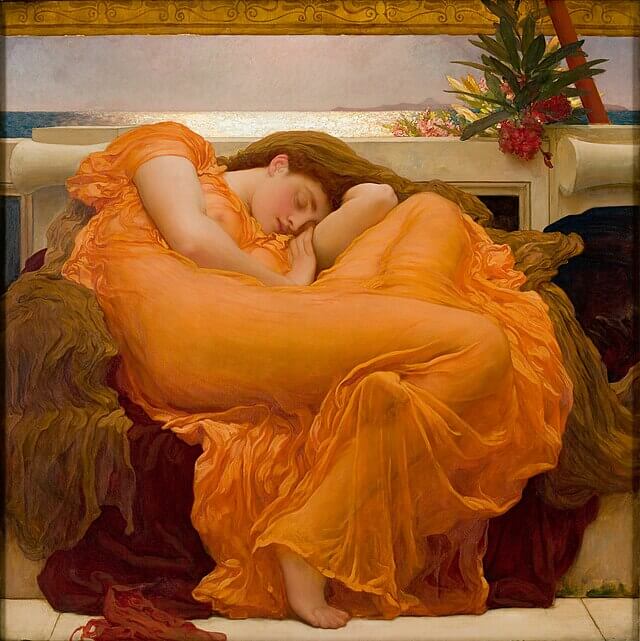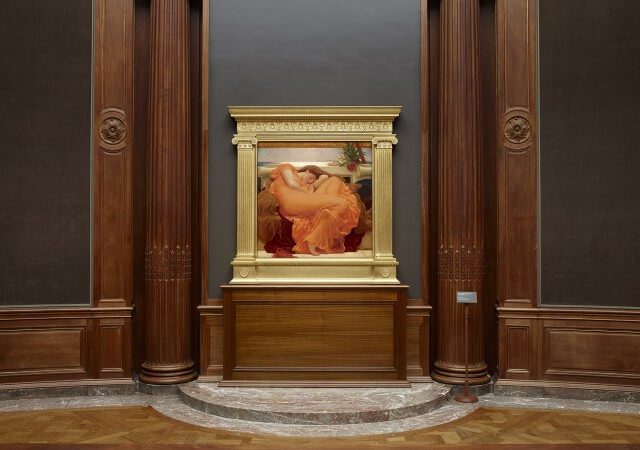Art historian and poet Monika critiques Frederic Leighton’s ‘Flaming June’, a timeless masterpiece, embodying Victorian neoclassicism through colour, form, and emotion, captivated by its intricate composition and symbolism, exclusively for Different Truths.
‘Flaming June’ by Frederic Leighton is a masterpiece that exemplifies the essence of aesthetic beauty and artistic brilliance. The painting, created in 1895, is a harmonious symphony of colour, form, and emotion. Leighton’s meticulous attention to detail is evident in the depiction of the reclining female figure, draped in vibrant orange and amber robes.
The subject’s serene expression and the play of light and shadow create a sense of tranquillity and warmth. The meticulous rendering of the fabric, from the delicate folds to the intricate patterns, showcases Leighton’s technical prowess. The choice of the vibrant colour palette, dominated by shades of orange and gold, not only adds visual richness to the painting but also enhances the overall sense of radiance.
The composition is carefully balanced, with the figure positioned at the centre…
The composition is carefully balanced, with the figure positioned at the centre, surrounded by billowing fabrics that seem to defy gravity. The use of symbolism, such as the poppy flowers, adds layers of meaning to the artwork, inviting viewers to contemplate themes of beauty, sleep, and the fleeting nature of time.
‘Flaming June’ is a testament to Leighton’s ability to capture a moment of timeless beauty and evoke a sense of contemplation. The painting’s enduring popularity is a testament to its universal appeal, transcending the boundaries of time and culture. In essence, “Flaming June” stands as a pinnacle of Victorian neoclassicism, showcasing the artist’s dedication to precision and his ability to convey profound emotion through visual art.
The muse for ‘Flaming June’ is not definitively known. Unlike some paintings where the model is well-documented, Leighton did not provide clear information about the woman depicted. This adds an element of mystery to the artwork, as the identity of the muse remains elusive, leaving room for speculation and interpretation. Art historians and enthusiasts continue to explore and theorize about the possible inspiration behind the painting.
The title ‘Flaming June’ is believed to be a play on words, as the painting was completed in June…
The title ‘Flaming June’ is believed to be a play on words, as the painting was completed in June, and the vibrant orange and amber colours used in the artwork give a sense of warmth and intensity, reminiscent of flames. The choice of the title not only reflects the season in which the painting was created but also adds a poetic and evocative element, capturing the attention of viewers and contributing to the overall allure of the artwork.
The timeless painting is considered a ‘Masterpiece’ because of these best reasons.

Composition and Technique: Frederic Leighton’s mastery of composition and technique is evident in every brushstroke. The carefully balanced arrangement of the reclining figure, the flowing fabrics, and the use of light and shadow showcase his artistic skill.
Colour Palette: The vibrant and harmonious colour palette, dominated by shades of orange and gold, is a striking feature. The warm tones not only convey a sense of visual richness but also evoke feelings of tranquillity and warmth, contributing to the painting’s emotional impact.
Symbolism: The inclusion of symbolic elements, such as the poppy flowers, adds depth to the painting. Poppy flowers are often associated with sleep and dreams, enhancing the narrative, and inviting viewers to explore themes beyond the visual aesthetics.
Timeless Beauty: ‘Flaming June’ captures a moment of timeless beauty. The subject’s serene expression and the ethereal quality of the scene transcend the specific time in which it was created, making it universally appealing across different eras and cultures.
Emotional Resonance: The painting conveys a sense of tranquillity and contemplation. The figure’s posture and the overall atmosphere evoke emotions and invite viewers to engage with the artwork on an emotional level.
Influence on Art History: ‘Flaming June’ is representative of Victorian neoclassicism and has had a lasting impact on art history. Its enduring popularity speaks to its significance and influence in the world of art.
The painting… has become an iconic representation of the classical style of the late 19th century.
The painting is celebrated for its aesthetic beauty and has become an iconic representation of the classical style of the late 19th century. Despite being underappreciated during Leighton’s lifetime, ‘Flaming June’ gained recognition and popularity in the 20th century, solidifying its status as a masterpiece in art history.
Without some poetry, the ethereal painting would be an incomplete one. I celebrate it in my poem:
In June's embrace, a vision bold, A tale in hues of orange told. Leighton's brush, a master's hand, Unveils a scene, enchantingly grand. Flaming June, in slumber's grace, A warmth that time cannot erase. Robed in amber's fiery embrace, A dreamscape spun, a tranquil space. Her gaze serene, a quiet plea, Soft whispers in the reverie. Poppy blooms, in a slumber trance, A dance with time, a fleeting chance. The fabrics flow like liquid fire, A symphony of hues to inspire. In Golden Glow, a timeless tune, A masterpiece is 'Flaming June'. Each stroke is a story, vivid, bright, Capturing moments in soft light. Neoclassic dreams unfurl, In the heart of summer's swirl. Oh, Flaming June, a canvas dream, Where time and beauty gently gleam. In amber robes, a poet's rune, A timeless hymn, a Flaming June.
Painting sourced : Museo de Arte de Ponce
Flaming June by Frederic Leighton






 By
By
 By
By
 By
By
 By
By